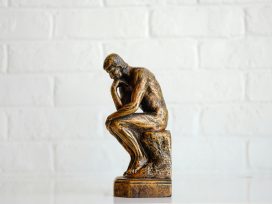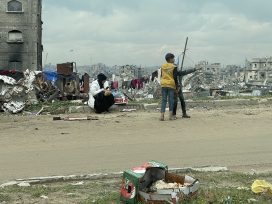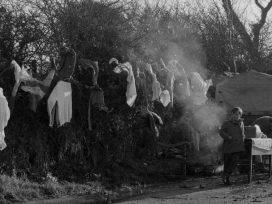Four middle-aged men embark on a weekend fishing trip. They drive into the mountains, park the car and hike several miles to where they want to fish. The first evening at the river, even before they have set up camp, they discover the corpse of a young woman, naked, floating face down in the water. They talk about what they should do and decide, rather than abandoning the trip, to delay reporting the body. Having tethered it to the shore, they spend the following day fishing, alerting the police only on their return.
This is the premise for a short story by American writer Raymond Carver. More accurately, it is the pretext; the girl, it transpires, was raped and murdered, but the story is concerned not so much with this tragedy as its aftermath. Grounded as always in the banal, Carver is interested not in the death itself (for which he offers no explanation), but how differing responses to an event of such magnitude can expose the emotional tensions that lurk just beneath the surface of everyday experience. Thus the story opens not with an account of the murder but with Stuart, who found the body, returning home, hungry and tired, sitting down to dinner. His wife, Claire, having learned what has happened, is horrified at her husband’s casual indifference, while he himself is unwilling, or unable, to recognise its profundity. “Something has come between us,” Claire confesses to the reader, “though he would like me to believe otherwise.”
“So Much Water So Close to Home”, first published in 1977, is typical of Carver’s fiction: a study in what he termed “dis-ease” – disillusionment and miscommunication in the lives of ordinary people. As usual, events are played out in this quotidian context; it is here, when the veneer of domestic harmony disintegrates, that we glimpse the malevolence beneath the mundane.
Chekhov once said that there are two “poles” to a story: “him” and “her”. Carver’s stories are often charged with a tension which owes much to the polarised attitudes of men and women, particularly as they manifest in moments of crisis. Here, in essence, we have a moral quandary: what are the obligations of the living to the dead? Carver suggests that men and women approach this issue very differently and that the rift that opens between Stuart and Claire functions as a microcosm of the gender division that exists in every marriage.
Carver’s world is immediately recognisable as proletarian America. His stories, almost without exception, are set in the American Midwest – though seldom in a specific time or place. Pervaded by a mood of timelessness, placelessness, isolation from politics and historical events, they seem to be happening both nowhere and everywhere. Carver himself confirmed a proclivity for the generic; his essentialist view of human nature urges us to read the American location of his stories as ultimately irrelevant. The contours of his world are defined not so much physically as psychologically; we are invited to enter not a place, but a predicament. This predicament, Carver would have us believe, is one of universal relevance.
This goes some way to explaining why, though by no means a household name, Carver has been translated into over twenty-five languages and his stories the subject of numerous adaptations for stage and screen. In 1993, Robert Altman included “So Much Water So Close to Home” in his patchwork homage Short Cuts, seamlessly transplanting Carver’s characters to a Los Angeles suburb. The filmmaker Ray Lawrence recently undertook a more daring upheaval, translating the story to his native Australia.
The town of Jindabyne lies in the foothills of the Snowy Mountains, New South Wales. In the 1960s, it was intentionally flooded by the damming of a river. The original settlement, left at the bottom of a newly created lake, was rebuilt nearby and is today a skiing and fishing resort. The town’s “drowned” history becomes an uncomfortable metaphor in Lawrence’s film: the implication of a submerged population provides an apt basis for addressing Carver’s themes of displacement and denial.
Jindabyne tries to remain faithful to the ethical core of the story on which it is based, while necessarily embellishing Carver’s frugal narrative. The strained relationship between Stuart and Claire continues to be of central concern here, though as we soon learn, theirs is not the only struggle – the other men and their partners must wrestle with skeletons in their respective closets also, while the community at large is forced to address some truths long suppressed.
Lawrence and his scriptwriter, Beatrix Christian, have endeavoured to make Jindabyne not only a film about male insensitivity and female empathy, but also an exploration of what these sexual politics might tell us about Australia’s current social climate. Until at least an hour into the film, we can read the men’s behaviour in fairly straightforward terms – further evidence, should any be required, of man’s capacity for inhumanity to man – or indeed, to woman. A feminist reading of the film would surely not overlook the brutal subjection of the murdered girl and would presumably speculate – as Claire does – that the men might have acted differently had the body they found been that of a boy. Before drawing any conclusions in this respect, however, we are forced to consider an even thornier question. The incident inevitably becomes a scandal in the hands of the local media and in a TV interview, the murdered girl’s family asks: “Would it have been different if she had been white?”
Here the film departs from Carver’s essentialist symposium on gender politics and attempts to address a problem of specific relevance to contemporary Australia. The dead girl is Aboriginal and her family’s assertion that the men’s neglect was racially motivated prompts condemnation from the Aboriginal community, who are quick to make accusations of “white hate crimes.” While never this explicit, we must now consider the possibility that the men’s indifference is not ethnically indiscriminate. So Jindabyne becomes, somewhat belatedly, a film about racism – or rather, a film about the latent racism embedded in contemporary Australian culture.
Since the earliest years of European settlement, Australia’s white immigrant, migrant and indigenous groups have been embroiled in fierce debate about “rights to belong.” As sociologist David Mercer has observed, the heady days of colonial vigour which followed the publication of Adam Smith’s Wealth of Nations made the “new” Australia “a kind of living laboratory for liberalism… where Social Darwinist ideas of white superiority… gave legitimacy to a raft of exclusionary and even eugenic policies.” And while the Commonwealth’s 1948 Nationality and Citizenship Act made it clear that all who were born in Australia – regardless of colour – were legally citizens, this piece of legislation proved to be an empty vessel; the evidence overwhelmingly suggests that Australia’s Aboriginals and Torres Strait Islanders still remain largely “citizens without rights”.
The question of citizenship has in recent years been the subject of growing public debate in liberal democratic societies. According to Mercer, this debate ought to be framed in the context of three core ideas that have gained widespread acceptance. First, that “the notion of citizenship has been debased and diluted from its original ideal of active participation to mere formal and passive membership”. Second, “the significance of past historical wrongs against particular ethnic or indigenous groups invariably is glossed over and the assumption is made that enlightened educational campaigns are all that are required to make redress”. And third, “there is the view that liberal democracies are now genuinely ‘multicultural’; people of all races, colours and creeds are treated equally and welcomed as citizens”. These ideas are seriously open to question, particularly in the context of Australia.
Today, Australia occupies an awkward liminal position, belonging neither to its Anglo-centred past nor an assuredly post-colonial future. The centenary of the Australian Constitution was marked in 2001 and with the recent election of a new Government, it is certainly timely to reflect on the changes that took place in the twentieth century – and to consider those ahead as we settle into the twenty-first.
The mainstream white views of Australia’s indigenous population have gradually shifted from complete indifference or active promotion of genocide, through assimilationism – a transparently racialist project with the clear aim of eliminating “minority” cultures through a continual process of absorption – to the current position of grudging recognition and “reconciliation”. Even the terminology is misleading. It implies that at some stage in the past the Aboriginal and non-Aboriginal people had a relationship which operated on mutually beneficial terms, that this relationship has deteriorated and that reconciliation is now a plausible (or even desirable) solution. A policy which in theory looks unrealistic at best, in reality has proved deeply insidious: former Prime Minister John Howard’s penchant for “practical reconciliation” often translated into savage cuts to many Commonwealth government programmes designed specifically to assist indigenous people. Earlier this year, a radically interventionist plan to tackle alcoholism and domestic violence in Australia’s most disadvantaged communities was denounced as racist by, among others, the Aboriginal Medical Services Alliance. The measures – including compulsory medical checks and bans on alcohol and pornography – and the motive – so nakedly a strategy to win votes in the run-up to an election – are in themselves questionable. More troubling, however, is institutionalised discrimination, which exacerbates the social malaise endemic in Aboriginal communities.
This discrimination operates in subtle ways. As Mercer notes:
70% of Aboriginal households in Western Australia are forced to live in rental accommodation and all but 8% of these rent their homes from the State public housing agency, Homeswest. In the 1990s the conservative State government’s agenda was to reduce State debt and one strategy was to escalate the eviction rate for bad debtors. Inevitably, the resultant institutional discrimination took a heavy toll on indigenous people. One estimate was that in 1998 around 60% of the evictions involved Aboriginal families even though less than 20% of public housing units in that State were taken up by indigenous people.
Aboriginal and Torres Strait Islanders, who together make up about 2.5 per cent of Australia’s population, live on average seventeen years less than their fellow citizens. The average life expectancy for Aboriginal men is fifty-nine, compared with seventy-seven for non-indigenous males, according to a 2006 report by the Australian Institute of Health and Welfare. Australia has the dubious distinction of being the only first world country with a dispossessed indigenous minority whose men, on average, will not live long enough to claim a retirement pension. Suicide rates among Aboriginals are between three and four times that of their non-indigenous counterparts. The educational level is much lower than the national average, the imprisonment rate as much as sixteen times higher. If, as Dostoyevsky suggested, the degree of civilisation in a society can be judged by entering the prisons, this statistic alone raises serious questions about the legitimacy of the Australian state and the extent to which it has continually failed its Aboriginal citizens.
The fundamental problem turns out to be the irreconcilability of two cultural ideologies. The principles of Australia’s liberal democracy give precedence to the rights of the individual over those of the group. In addition, with its emphasis on economic liberty, the liberal democratic state has considerable difficulty dealing with spiritual values that are so central to Aboriginal being.
Australia today remains a deeply conservative country. The latent desire to remain a white liberal state, unchallenged by ethnic minority discontent is evidenced by increasingly stringent control of its indigenous population. There is a perception that escalating flows of immigrants threaten to compromise the very idea of territory as a sovereign space over whose borders an authorised public has the sole right of movement, ownership and voice. Anderson and Turner, in “Exclusionary Politics and the Question of National Belonging”, write:
Anxieties reached a peak in late 2001 around the “Tampa affair”, when the conservative Howard government intercepted and denied 433 rescued asylum seekers entry into Australia and precipitated an international controversy… [T]his moment at which Howard drew “a line in the sea” to keep asylum seekers out, was one of moral crisis for Australia. “Border protection” became the catch-cry that justified an immediate series of official exclusionary practices. (Ethnicities vol. 5 no. 4)
The perception of an external threat, in the form of immigrant invasion, can be linked with an internalised settler-society anxiety embedded within the problematic colonial origins of the Australian nation and the thwarted cultural codes of its indigenous population. The latter’s dispossession, argue Anderson and Turner, “casts a shadow over the unproblematic heroic narratives of ‘white settlement’ and continues to haunt the discourses of a benign and united sovereign nation.” An apology for past injustices to indigenous Australians remained an “unsayable” act for John Howard for the duration of his tenure. As a symbolic disavowal of the country’s “black history,” Howard’s stance suggests “a kind of historical defensiveness that is analogous with defending the assumed-to-be-white space of the nation.”
In short, racism in Australia seems to be tied to the spatial dimension of its settlement project, where an antipodean sense of place manifests as “spatial anxiety”. In Jindabyne, we can read the behaviour of the men as representative of the latent racism in contemporary Australia – racism founded on an attitude of indifference and manifest now in a crisis of belonging. Significantly, the character of Stuart, in Lawrence’s reworking, is attributed an Irish heritage, which seems to be a deliberate attempt on the part of the director to approach the problem of settler anxiety. The fishing trip, which has become an annual ritual in the lives of these men, stands for a primal urge to reconnect with the land. Discovering the girl’s body is, in a sense, a violation of this impulse; while their subsequent behaviour cannot be excused, it can, in this light, be better understood.
Likewise, Claire’s reaction can be seen as symptomatic of the same anxiety, albeit surfacing not in moody denial but a post-colonial guilt complex. She too is an immigrant and, as a reviewer in the New York Times puts it, “stereotypically American” in her handling of the trauma, “pushing toward the therapeutic goals of healing and closure, while her white Australian friends urge her to move on and let go of her fury and shame”. Enraged by the complacency of Jindabyne’s predominantly white population, she embarks on an ill-advised fund-raising campaign, seeking to make some reparation to the Aborigine community, only to be rewarded with hostility from both.
Stuart’s unwillingness to accept responsibility for his actions and Claire’s clumsy efforts toward tolerance and respect, are, in essence, two stages in the same process. Jindabyne‘s proposal – that racism has not yet been eradicated from white post-colonial societies, that it lurks, submerged, within a population’s consciousness – is an important idea, explored here with intelligence and tact. It is, for the most part, an intricate and well conceived film, though, as A.O. Scott points out, “too many of the incidents, sub-plots and conversations have been stuffed into the delicate vessel of Carver’s story, rather than allowed to grow organically out of it.” Carver is a master of ellipsis; often his stories resonate not with what is said, but what is left unsaid. Something of this has apparently been lost in the translation from page to screen (or from short story to feature-length film): Jindabyne seems at times disconcertingly like a soap opera. Arguably however, the film’s greatest flaw comes in its denouement, which features an Aboriginal smoking ceremony and an unlikely convergence of oppositions that the rest of the film has carefully teased apart. Here, men and women, whites and Aborigines, the sacred and the secular, even the living and dead, are reconciled, momentarily at least, in what approximates a happy ending. This reconciliation feels contrived and unconvincing, an injustice to the enquiry initiated by the film.
While we could scarcely expect Jindabyne to offer a solution to Australia’s problem of latent racism, we might have hoped, as we hope now of Australia’s newly elected government, for emphasis not on “reconciliation” and “consensus”, but more realistic goals of accommodation and compromise.






